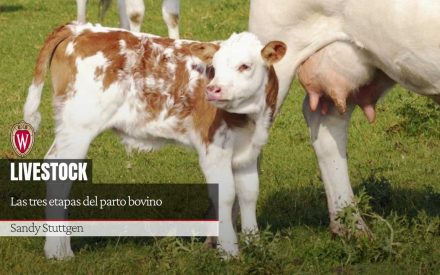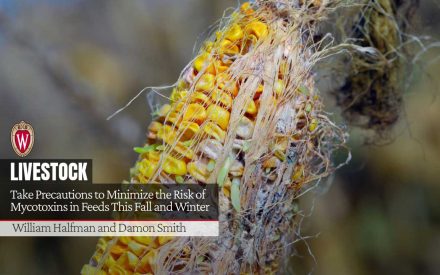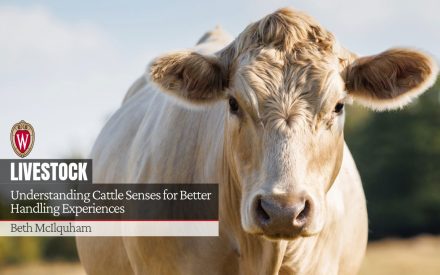We often think of pinkeye as only a summer problem; and in Wisconsin, July-August is a key time to be watchful for the contagious pinkeye that develops in response to eye irritation from UV light and physical eye irritation from mature grass/seed heads, blowing dust/sand and flies, primarily face flies.
Pinkeye vaccination may help reduce the symptoms of the disease, but due to the lag in vaccine induced immunity you cannot vaccinate your way out of a pinkeye crisis. Read Pinkeye Vaccination Programs and Managing and Preventing Pinkeye to learn more about vaccination and why pinkeye is not just a summer problem.
Consult with your veterinarian for treatment options when the first animal exhibits eye irritation and by that, I mean excessive tearing and squinting. Do Not Wait until multiple cattle’s eyes are swollen, red or are white or ulcerated to begin treatment and to ramp up fly control measures. Face flies quickly and efficiently spread the bacteria that causes pinkeye between infected and non-infected eyes.
Face flies (Musca autumnalis) are active during hotter days, awake and feeding on eye and muzzle secretions of cattle in bright sunlight. They are resting, and not feeding during the night. Face fly eggs are laid in freshly deposited manure (less than 15 minutes old). Control of face flies is achieved by regular application of insecticides to animals’ face and fly breeding sites in fresh manure.
Adult flies lay eggs independently of one another, so eggs are constantly being laid in the summer. Immature fly stages feed on the manure and it takes about one month to complete their development to an adult that feeds on cattle faces. Adult face flies overwinter buildings.
Bringing cattle in the barn or under shade during the hot sun-filled days will reduce their exposure to face flies. Removing the sun’s glare greatly reduces the pain associated with pinkeye. Barns need to be ventilated during the summer to prevent respiratory and problems associated with other flies from developing.
Using organophosphate or permethrin type products in dust, oil applications and sprays can be helpful to repel face flies. When using dust bags or oilers, make sure to hang them low enough so cattle can lift them and rub their head with them. Place them where cattle are forced to use them: above the waterer, cross-over lanes, doorways, or hung along the feeder wagon or bale feeder.
Insecticidal ear tags are labeled primarily for horn flies. Some products have face fly indications. Read the label to select products that control both. Use fly ear tags as the label directs Adults usually need one in each ear; the calf usually needs one tag. Tag the calf too, as the calf will receive the flies repelled from the cow’s tags, and the calf is more susceptible to pinkeye.
Check the label’s duration of activity and wait to apply tags so active ingredient is present when it is most needed. Face flies are a summer fly, especially active during the hotter days of July and August. Most products say they have coverage for five months, but effectiveness is reduced as the tags get covered with mud, or are snagged, torn, and ripped out by cattle scratching or throwing their heads because of fly irritation. The impregnated compound is swiped across the animal’s shoulders, sides, and legs as they reach to knock flies from their body.
Insecticide resistance is developing, so switch tag ingredients between seasons. Timely remove tags. Leaving them in leads to sub-therapeutic dosing which creates resistance.
Tetrachlorvinphos (RabonÒ) as an oral feed-through product is labeled for face flies. To be an effective oral larvicide, it must be dosed to the animal’s weight, be consistently consumed every day, and fed throughout the entire fly season. Remember face flies are summer flies, so think about adding larvicidal products to feed beginning in mid-July, perhaps when grass is less lush, and cattle are more likely to consume supplemental feed.
No pour-on insecticidal products are specifically labeled for face flies. Some are labeled for stable and house flies that are in the same fly family as face flies, but passage of the ingredient into fresh manure has not been proven to be an effective face fly larvicide.
According to “Face Fly Biology and Management”, West Virginia Extension Service, face flies are attacked by parasitic nematodes, and immature stages of both horn flies and face flies are attacked by predaceous mites, predaceous beetles, and parasitoids.
Manure competitors such as dung beetles also limit fly populations by removing and burying cattle dung before immature flies can complete their development. Adult flies are attacked by predaceous yellow dung flies, and face flies are occasionally attacked by pathogenic fungi. Parasitoid releases for house fly and stable fly control are not effective against pasture face flies.
Face flies can travel for miles, research has shown their range is about eight miles in five days. Fly control is difficult when your neighbor’s flies are not being controlled. You may have more problems with flies when your neighbor is using repellant methods and you are not.

 Ayudar las vacas y a los terneros a recuperarse después de una Distocia
Ayudar las vacas y a los terneros a recuperarse después de una Distocia Las tres etapas del parto bovino
Las tres etapas del parto bovino Take Precautions to Minimize the Risk of Mycotoxins in Feeds This Fall and Winter
Take Precautions to Minimize the Risk of Mycotoxins in Feeds This Fall and Winter Understanding Cattle Senses for Better Handling Experiences
Understanding Cattle Senses for Better Handling Experiences


